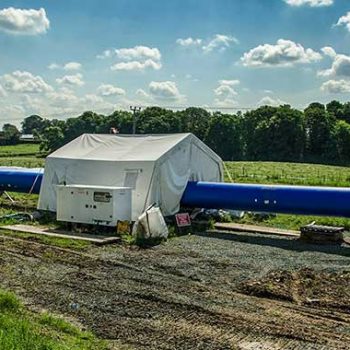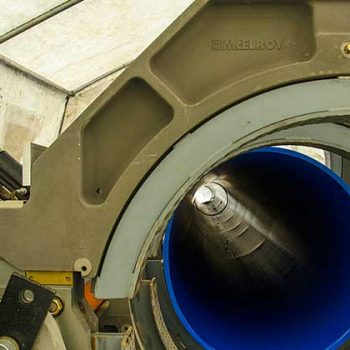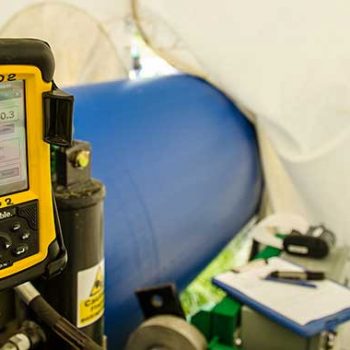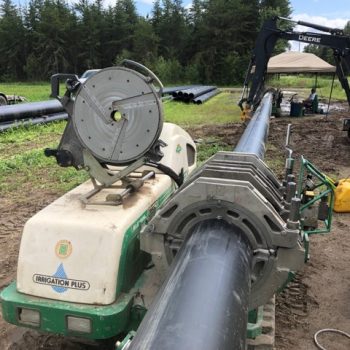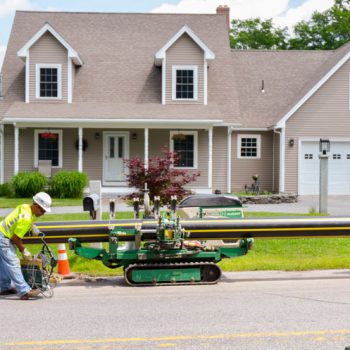In the Victorian era, England underwent an amazing population boom. With more people, came more needs for services. During this time, large-scale water and sewer infrastructure were created throughout the country.
It was a time of doing things bigger and better than before. One of the larger projects of the time created two pipelines from Lake Vyrnwy to Liverpool, both lines being made of cast iron of anywhere between 39 to 42 inches in diameter. Constructed in the 1880s, the pipelines were an advancement at the time as cast iron was just coming into its own as a pipeline for large water mains.
After 130 years, those cast iron water mains are getting revamped with the latest pipe materials and advanced installation methods.
We need 8 welds a day to make it pay
Together, the Vyrnwy Large Diameter Trunk Main (LDTM) is a series of three pipelines that carry water to more than 900,000 customers in the counties of Cheshire and Merseyside. The last of the three pipelines, a bitumen-lined steel pipeline, was built in the 1930s to run alongside the existing two.
Realizing how critical the three pipelines were to carrying approximately 210 million liters to customers each day, United Utilities undertook an aggressive rehabilitation and improvement plan that began in 2009. The lines suffered from build-up of iron and manganese, which is a natural occurrence in raw water pipelines. The build-ups don’t pose health risks, but can result in discoloration of the water and be detrimental to the health and flow capacity of the pipeline.
One of the goals of the long-term project was to rehabilitate the lines, while ensuring no disruptions in service to customers. To start the strategic rehabilitation, specialized jet-pressure equipment blasted the inside of 28.5 kilometers of the newest line between Oswestry and Malpas.
Following the improvements to line 3, work began on refurbishment of the older lines in 2011. Officials chose several techniques to initially test, including using a folded liner inserted into the original pipe, as well as swagelining. Both processes take polyethylene pipelines that have been fused together and manipulate the pipe to become a new liner within the existing pipeline.
Swagelining was chosen after testing to be the preferred technical solution and was ultimately chosen for Phase 1 and future phases of the project. The process takes the polyethylene pipeline, and using specialized equipment, reduces the natural diameter of the pipeline to fit within the existing pipeline. Denholm Pipeline’s personnel had more than 20 years using this technique in projects all over England. The folded liner technique uses specialized equipment to deflect part of the pipe inward to reduce the diameter. After being inserted into the host pipe, the pipe is then pressurized to put the line into service and bring the pipe back to an oval or round shape.
Two lines of 9 kilometers each would be needed to rehabilitate lines 1 and 2 between Oswestry and Crickett. To create the polyethylene liners, workers from Denholm fused together PE100 pipe materials at several different sites. Access holes were created at different places to insert the polyethylene liner into the older pipelines. The sections that were worked on were selectively chosen to minimize the possibility of disruptions in service.
Fusion Operations
To join the Radius PE100 SDR 51 pipes larger than 1,000mm in diameter, several McElroy MegaMc® 1648 machines were utilized. United Utilities, Balfour Beatty Civil Engineering and Denholm Pipecare consulted McElroy distributors MCA and Plant and Site Services to rent or “hire” the fusion machines.
Plant and Site Services is a provider of joining equipment and pipe with offices is St. Albans, Bristol, Wolverhampton and Wetherby. MCA, part of Drain Center, is a supplier of butt fusion and pipe with locations in Bristol, Sheffield, Glasgow, Luton and Bolton.
The MegaMc 1648 allowed workers on site to be more productive, producing more fusion joints per day.
“We need 8 welds a day to make it pay,” said Mike Baker, assistant project manager with Denholm Pipecare. “At times, we are achieving up to 10 welds a day.”
Others on site were just as impressed.
“The machines are great,” said Tim Newton, project manager with Denholm Pipecare. “The level of production is good. We’re getting to the point where we’re doing one pull a week.”
Sixteen out of 31 pulls had been completed by the middle of June 2012 for a total of 8,500 kilometers in the ground.
One advantage of turning to a McElroy large-diameter machine was the ability to “tent” the machine. Other machines on the market often require a crane or lifting apparatus to lower the facer and heater into the carriage, which makes protecting the joint from the elements near impossible. Tenting of fusion machines is typically required on jobsites in the United Kingdom, along with specifications to put protective covers on pipe ends.
In addition to consulting with McElroy distributors on equipment and training, supportive equipment was also used on site. The McElroy DataLogger® was used to record and document fusion operations of each joint on the project. Pipe stands were used to support pipe lengths as they were being fused and pulled along the right of way.
With the magnitude and importance of the project, the DataLogger was used to record and document each joint made. The DataLogger consists of a hand-held computer that operates as a device that records heater temperature and the fusion pressure profile over time. All data is recorded and stored on the hand-held until a time is available to download the data to a desktop computer. The graphs generated can be stored, viewed, printed and archived.
Pipe stands allowed the pipe to be level with the fusion machine, as well as the holes in the tent. The stands help save wear and tear on the machine, and can aid in lining up the high/low to get an even face-off.
Project Completion
The pipeline work from Oswestry to Crickett represents Phase 1 of the three phase project. Polyethylene will play a big role in the rehabilitation of lines 1 and 2 from Crickett to Malpas during Phase 2 and from Malpas to Prescot in Phase 3.
Project manager, Tim Newton also stated that “we hope to be finished with the fusion process of Phase 1 at the end of October. Phase 2 would start at the end of August (2012).”
